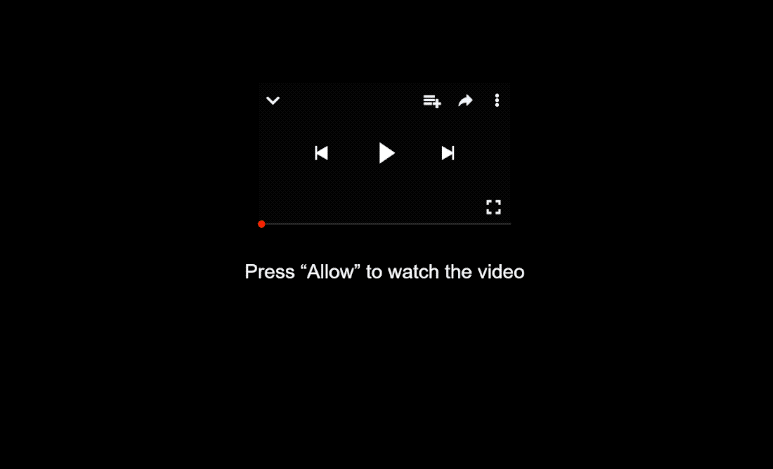Remove squetofer.com pop-up ads
squetofer.com is a misleading site and aims to deceive users into enabling advertisements on their desktops. When you visit the site, you’ll see a browser alert saying “squetofer.com wants to show notifications”. This site exploits a legitimate browsing feature that allows notifications to be displayed on users’ desktops. If you click “Allow”, you grant squetofer.com permission to show notifications on your desktop, which will unfortunately be advertisements. However, it’s easy to revoke a site’s permission to display notifications via your browser’s settings.
As with many websites exploiting the “show notifications” feature, squetofer.com shows nothing more than a fake video player that stops after just 10 seconds. Once the player stops, a browser alert appears, prompting you to click “Allow” to verify that you’re not a robot. This alert refers to the alert saying “squetofer.com wants to show notifications”. By clicking “Allow”, you permit the site to display desktop advertisements, which can be quite annoying. These ads may mimic legitimate system notifications to deceive users into interacting with them. A common type of ad from sites like squetofer.com is a fake virus alert that closely resembles an actual notification from an antivirus program. Interacting with these false alerts could lead you to untrustworthy websites that promote unreliable software or potentially harbor malware.
If you have allowed squetofer.com to display notifications, you can easily revoke this permission in your browser’s settings. You can find instructions for this at the end of this report. Additionally, since these redirects may indicate adware on your system, we recommend performing a scan using the WiperSoft antivirus program. Installing an ad blocker is also recommended.
Why are you redirected to sites like squetofer.com?
When navigating websites filled with advertisements and without an adblocker, it’s common to experience random redirections no matter what you click. These sites tend to bombard users with ads to generate income, and those featuring adult or pirated content are particularly notorious for such behavior. A reliable adblocker can effectively shield you from disruptive ads and unwanted redirects.
If you notice an increase in ads and redirects—especially on sites that previously posed no issues—this may indicate the presence of adware on your device. Adware and browser hijackers usually infiltrate systems through a method called software bundling. This method involves unwanted programs being bundled with popular free software as additional offers. Although these offers are technically optional, users must manually opt out to prevent installation. Unfortunately, these offers are often hidden in settings users rarely use, causing many users to not notice them and not uncheck the boxes. Consequently, programs using this method can be flagged as potential threats by antivirus software.
To prevent unwanted clutter on your computer, choosing the appropriate settings during the installation of free programs is essential. You typically have the option to choose between Default and Advanced settings. Default settings, which the installation window often recommends, will automatically install all bundled offers without explicit consent. In contrast, Advanced settings display each offer, giving you the chance to uncheck any that you don’t want to install. It’s a good idea to uncheck all offers—even if they appear useful at first—to keep your computer free from unnecessary junk.
How to remove squetofer.com notifications
Unexpected redirects may suggest an adware infection, so it’s advisable to scan your computer with WiperSoft antivirus software. Additionally, if you haven’t already, install an adblocker. This can help minimize ads and redirects while browsing sites that tend to be ad-heavy.
If you’ve allowed a suspicious website to send you notifications, you can retract this permission through your browser settings. If you’re unsure how to do this, you can find instructions below. Alternatively, to avoid notification requests altogether, you can disable this feature completely.
- For Mozilla Firefox: Open Menu (the three bars top-right corner) -> Options -> Privacy & Security. Scroll down to Permissions, press Settings next to Notifications, and remove squetofer.com and any other questionable websites. You can permanently turn off these notification requests by checking the “Block new requests asking to allow notifications” box in the same Notifications settings.
- For Google Chrome: Open Menu (the three dots top-right corner) -> Settings -> Privacy and security -> Site Settings. Click on Notifications under Permissions, and remove squetofer.com and any other questionable websites. You can stop these notification requests permanently by toggling off “Sites can ask to send notifications”.
- For Microsoft Edge: Open Menu (the three dots top-right corner) -> Settings -> Cookies and site permissions -> Notifications. Review which sites have permission and remove squetofer.com and any other questionable websites. You can permanently turn off these notification requests by toggling off “Ask before sending”.
Site Disclaimer
WiperSoft.com is not sponsored, affiliated, linked to or owned by malware developers or distributors that are referred to in this article. The article does NOT endorse or promote malicious programs. The intention behind it is to present useful information that will help users to detect and eliminate malware from their computer by using WiperSoft and/or the manual removal guide.
The article should only be used for educational purposes. If you follow the instructions provided in the article, you agree to be bound by this disclaimer. We do not guarantee that the article will aid you in completely removing the malware from your PC. Malicious programs are constantly developing, which is why it is not always easy or possible to clean the computer by using only the manual removal guide.

